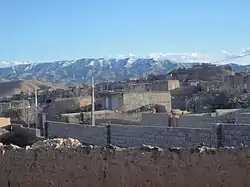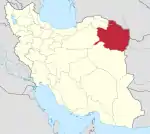Madan-e Olya
Madan-e Olya (Persian: معدن عليا, also Romanized as Ma‘dan-e ‘Olyā; also known as Ma‘dan-e Bālā, Bār-e Ma‘dan-e Bālā, Bār Ma‘dan ‘Olyā, Ma‘dan, and Maidān)[3] is a village in Firuzeh Rural District of the Central District of Firuzeh County, Razavi Khorasan province, Iran.
Madan-e Olya
Persian: معدن عليا | |
|---|---|
Village | |
 | |
 Madan-e Olya | |
| Coordinates: 36°28′30″N 58°24′36″E[1] | |
| Country | |
| Province | Razavi Khorasan |
| County | Firuzeh |
| District | Central |
| Rural District | Firuzeh |
| Population (2016)[2] | |
| • Total | 579 |
| Time zone | UTC+3:30 (IRST) |
At the 2006 National Census, its population was 557 in 164 households, when it was in the former Takht-e Jolgeh District of Nishapur County).[4] The following census in 2011 counted 543 people in 166 households, by which time the district had been separated from the county to participate in the establishment of Firuzeh County.[5] The latest census in 2016 showed a population of 579 people in 182 households; it was the largest village in its rural district.[2]
The historic Nishapur turquoise has been mined from the Rivand mountain near this village. An ancient city called Rivand of Nishapur has also been probably situated around the region of this village. Some Iranologists, believe that Rivand Mountain has been home to Adur Burzen-Mihr (a holy Zoroastrian fire temple).[6]
References
- OpenStreetMap contributors (29 April 2023). "Madan-e Olya, Firuzeh County" (Map). OpenStreetMap. Retrieved 29 April 2023.
- "Census of the Islamic Republic of Iran, 1395 (2016)". AMAR (in Persian). The Statistical Center of Iran. p. 09. Archived from the original (Excel) on 2 April 2022. Retrieved 19 December 2022.
- Madan-e Olya can be found at GEOnet Names Server, at this link, by opening the Advanced Search box, entering "-3073312" in the "Unique Feature Id" form, and clicking on "Search Database".
- "Census of the Islamic Republic of Iran, 1385 (2006)". AMAR (in Persian). The Statistical Center of Iran. p. 09. Archived from the original (Excel) on 20 September 2011. Retrieved 25 September 2022.
- "Census of the Islamic Republic of Iran, 1390 (2011)" (Excel). Iran Data Portal (in Persian). The Statistical Center of Iran. p. 09. Retrieved 19 December 2022.
- Boyce, Mary (2001). Zoroastrians : their religious beliefs and practices. London: Routledge. p. 88. ISBN 9780415239028.
